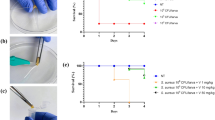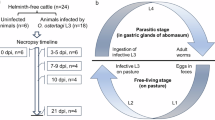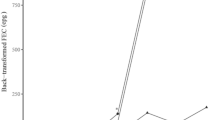Abstract
IT has been shown in calves which have experienced a substantial initial infection of H. placei that they develop a high level of immunity to further larval challenges and that the removal of a mature adult burden with phenothiazine therapy appears to delay the development of the immunity1,2. More recent work where calves had mature H. placei surgically implanted into the abomasum indicated that the implant conferred no immunity to the recipient calves to a challenge with 10,000 infective larvæ3.
This is a preview of subscription content, access via your institution
Access options
Subscribe to this journal
Receive 51 print issues and online access
$199.00 per year
only $3.90 per issue
Buy this article
- Purchase on SpringerLink
- Instant access to full article PDF
Prices may be subject to local taxes which are calculated during checkout
Similar content being viewed by others
References
Roberts, F. H. S., Austral. J. Agric. Res., 8, 740 (1957).
Roberts, F. H. S., and Keith, R. F., Austral. Vet. J., 35, 409 (1959).
Ross, J. G., Armour, J., and Hart, J. A., J. Parasitol., 48, 496 (1962).
Rick, R. K., and Keith, R. F., Austral. Vet. J., 34, 93 (1958).
Author information
Authors and Affiliations
Rights and permissions
About this article
Cite this article
ROSS, J. Immunogenic Activity of the Larval Stages of Haemonchus placei. Nature 197, 1221–1222 (1963). https://doi.org/10.1038/1971221b0
Issue date:
DOI: https://doi.org/10.1038/1971221b0



